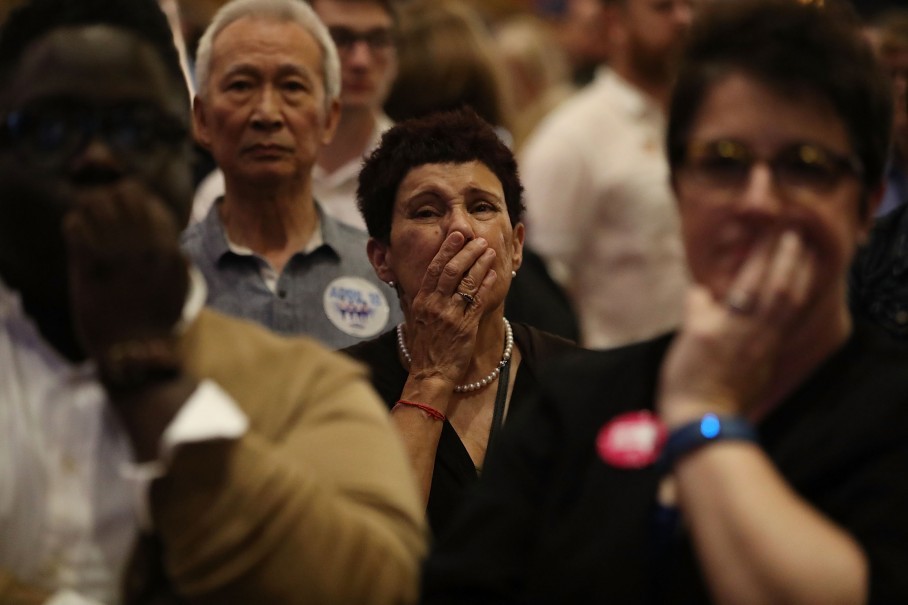 |
| Jon Ossoff speaks at his party last night. (Joe Raedle/Getty Images) |
WASHINGTON POST, THE DAILY 202, JAMES HOHMAN
The results from Georgia’s special election should scare Republicans, but Democrats shouldn’t overread the results. Democrats remain unlikely to win the House in 2018
With all the precincts reporting, Democratic candidate Jon Ossoff pulled 48.3 percent of the vote in the open House race to replace Health and Human Services Secretary Tom Price. He needed to break 50 percent in the jungle primary to avoid a head-to-head June runoff with the top Republican finisher.
Money mattered. Ossoff raised more than $8.3 million with the help of celebrities and the liberal netroots. About 95 percent of that haul came from outside Georgia.
 |
Supporters of Democratic candidate Jon Ossoff watch election returns on TV last night in the special election for Georgia's 6th Congressional District. (Joe Raedle/Getty Images)
|
------
-- Several of the takeaways I wrote about last Wednesday after the unexpectedly close special election in Wichita Kansas, are now doubly true: This will make GOP recruiting harder. Some House Republicans might become scared about being vulnerable and change their behavior. Congressional Democrats are going to become less likely to bail out House GOP leadership on tough votes. Democratic campaign committees will face more pressure than ever from the left flank to spend money in red districts, even if there’s no realistic path to victory.
While it votes Republican, the district’s demographics – affluent and highly educated suburbs north of Atlanta -- make it well-suited for Democrats to pick off in the age of Trump:
Consider this: Democrats control nine of the 10 congressional districts with the highest percentage of college-educated voters. Georgia-6 is the only exception, Dante Chinni pointed out last week in
the Wall Street Journal.
A lot of these center-right, upper-middle-class, well-educated professionals view Trump warily.
-------
[BUT] Picking up 24 seats to win control of the House will still be very hard for Democrats. Despite all the national help Ossoff got, he only outperformed Hillary by about 1 point in the district.
“To win back the House, coming close won’t be enough,” National Journal political editor Josh Kraushaar writes this morning. “Republicans were able to use their traditional playbook (to force a runoff), painting Ossoff as a down-the-line liberal to stunt his momentum. If that strategy works in the midterms, they’ll be well-positioned to hold their House majority. Democrats need to win these types of diverse, affluent Republican districts to regain control of the lower chamber. … All told, it doesn’t look as if many typical Republican voters -- even those who don’t care for Trump -- were inclined to vote for a Democrat to send a message…
“If there’s anything that should concern Democrats, it’s that they know what they’re against but not what they’re for,” Josh adds. “They’ve mastered the art of mobilization in the age of Trump, but are still struggling to persuade winnable voters. Ossoff’s campaign ads struck all the right notes, portraying him as a fiscal conservative and a pragmatist who’s tough on national security. But on the stump, Ossoff never really articulated much beyond bland Democratic talking points.
With their pumped-up base, Democrats should have a productive midterm election. But to capture a House majority, they’ll need to pick off Republican-friendly seats with candidates who can reassure GOP-leaning voters with a moderate message. Balancing the energy of the progressive activists with that sort of pragmatism won’t be an easy task.”
-----
-- Doug Sosnik, who served as Bill Clinton’s White House political director, believes Democrats are unlikely to win control of the House next year. Barring a complete Trump meltdown, the Democratic strategist thinks that the path is just too tough because the last round of redistricting was so effectively controlled by Republicans in many states.
The way he sees it, the significance of the 2017-18 cycle is largely about the 2020 presidential campaign and, as importantly, political power in the next decade surrounding reapportionment and redistricting.
The GOP’s performance in the 2010 midterm election positioned the party to dominate in the House for the entire decade. Consider that, in 2012, Republicans controlled the chamber despite getting 1.2 million fewer overall votes across all the House races. That’s how important it is to be able to draw the lines. (See slide 19.)
This also helps explain why there has been a steady decline in true swing seats since the 1990's. Red districts have gotten redder and blue districts bluer. There are fewer and fewer split districts. (See slide 10-12.)
Most of the tea party incumbents are unlikely to lose, so the action is going to be more in the moderate districts. (See slide 12.)
House races still matter, of course. How many seats the Democrats gain will affect Trump's ability to govern. That will impact whether he can hold the White House in 2020.
Due to the nature of the states with elections in 2018, Doug also thinks the Democrats are unlikely to take back the Senate for the rest of the decade. Again, barring a complete Republican meltdown. (See slides 7-9.)
Governors who win in 2018 will likely drive the redistricting process across the country. There are 38 governors races this cycle. Half are in open seats. There are contests in nine of the country’s 10 largest states. The outcome in these races will go a long way in determining who is in charge until the end of the 2020s. (See slides 15-16. Slide 20 shows who dominates the process in each state.)
History says that the party out of power should be highly motivated and do well. There seems to be signs of that now, but is it real? The greatest single question mark, which no one got right in 2016, is who is going to vote. That is even more difficult to predict in an off-year election. (See slide 24.)





/cdn0.vox-cdn.com/uploads/chorus_image/image/51359689/520988012.0.jpg)
/cdn0.vox-cdn.com/uploads/chorus_image/image/50368145/534525886.0.jpg)


